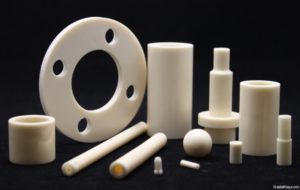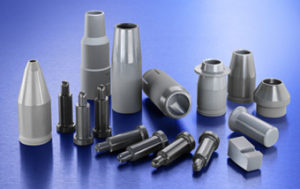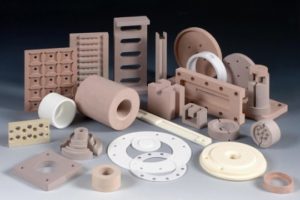- Alumina
- Boron Nitride
- Zirconia
- Other Ceramics
- Applications
- Contact

China Special Ceramic Parts, Inc. can be divided into structural ceramics, tool ceramics, and functional ceramics according to their different uses. Next, we will talk about China Special Ceramic Parts, Inc. from each category.
Structural ceramics have excellent strength, hardness, insulation, thermal conductivity, high temperature resistance, oxidation resistance, corrosion resistance, wear resistance, high temperature strength and other characteristics. It can exhibit high stability and excellent mechanical properties under very harsh environmental or engineering application conditions. The main materials of structural ceramics are alumina ceramics (Al2O3), silicon nitride ceramics (Si3N4), silicon carbide ceramics (SiC), and hexagon boron nitride ceramics (BN).
The main composition of alumina ceramics is Al2O3, and the general content is more than 45%. Alumina ceramics have various excellent properties such as high-temperature resistance, corrosion resistance and high strength, which is 2~3 ordinary ceramics. However, alumina ceramics have the disadvantage of being brittle and unable to accept sudden changes in ambient temperature. Alumina ceramics are widely used as the crucible, engine spark plug, high-temperature refractory, thermocouple sleeve, sealing ring and so on.
Si3N4 is the main component of silicon nitride ceramics, which is a kind of high-temperature ceramics with high strength, high hardness, abrasion resistance, corrosion resistance, and self-lubrication. The linear expansion coefficient of silicon nitride is the smallest among all kinds of ceramics, and it has excellent electrical insulation and radiation resistance. It has excellent corrosion resistance, and it can withstand the corrosion of various acids except the hydrofluoric acid, as well as alkali, corrosion of various metals. Silicon nitride ceramics can be used as high-temperature bearings, sealing rings used in corrosive media, thermocouple sleeves, and metal cutting tools.

Structural Ceramics
Silicon carbide ceramics are mainly composed of SiC, which is a kind of high-temperature ceramic with high strength and high hardness. When used in the high temperature of 1200 ℃ ~ 1400 ℃, silicon carbide ceramics can still maintain a high bending strength. In addition, silicon carbide ceramics also have good thermal conductivity, oxidation resistance, electrical conductivity, and high impact toughness. It is a good high-temperature structural material and can be used for rocket tail nozzle, thermocouple sleeve, furnace tube, and other high-temperature components.
The main composition of hexagonal boron nitride ceramics is BN, and the crystal structure is hexagonal crystal system. The structure and performance of hexagonal boron nitride ceramics are similar to graphite, so it is known as “White Graphite “. Hexagonal boron nitride ceramics are of low hardness and can be machined with self-lubricating properties, and they can also be made into self-lubricating high-temperature bearings and glass-forming molds.
The main materials of tool ceramics are cemented carbide, natural diamond (diamond), cubic boron nitride (CBN), etc.
Carbides are mainly composed of carbides and binders. Carbides mainly include WC, TiC, TaC, NBC, VC, etc., and binders are mainly cobalt (Co). Compared with the tool steel, cemented carbide has a high hardness (87 ~ 91 HRA), good red hardness (1000 ℃) and excellent wear resistance. When used as a cutter, its cutting speed is 4~7 times higher than that of HSS, and its service life is 5~8 times higher. However, its disadvantages are high hardness, brittle, and difficult to be machined, so it is often made into a blade and welded on the tool rod for use. Carbide is mainly used for machining tools; Various dies, including drawing die, drawing die, cold heading die; Mining tools, geology, and petroleum use a variety of drill bits, etc.
Natural diamond (diamond) is a precious ornament, while synthetic diamond is widely used in the industry. Diamond is the hardest material in nature and has a very high elastic modulus, and the thermal conductivity of diamond is the highest among known materials. Besides, diamond has good insulation, which can be used as the drill bit, cutter, grinding tool, drawing die, dressing tool. However, the thermal stability of the diamond tool is poor, and the affinity with iron group elements is large, so it can not be used for processing iron, nickel-based alloy, but mainly for processing non-iron metal and non-metal, widely used in ceramics, glass, stone, concrete, gem, agate and other processing.

Tool Ceramics
Cubic boron nitride (CBN) has a cubic crystal structure, and its hardness is second only to diamond. The thermal and chemical stability of cubic boron nitride is better than that of diamond, and it can be used for cutting hardened steel, wear-resisting cast iron, thermal spraying material, nickel, and other difficult materials.
Other tool ceramics are alumina, zirconia, silicon nitride, and other ceramics, but they are not as good as the above three tool ceramics from the comprehensive performance and engineering applications.
Functional ceramics usually have special physical properties and cover many fields, and the characteristics and applications of common functional ceramics are as follows.
Performance: Insulation, thermoelectric, piezoelectric, strong dielectric
Material composition: Al2O3, Mg2SiO4, BaTiO3, PbTiO3, LiNbO3
Application: Integrated circuit substrates, thermistors, oscillators, capacitors
Performance: Fluorescence, luminescence, infrared transmittance, high transparency, the electrochromic effect
Material composition: Al2O3CrNd glass, CaAs, CdTe, SiO2, WO3
Application: Laser, infrared window, optical fiber, display

Functional Ceramics
Performance: Soft magnetism and hard magnetism
Material composition: ZnFe2O, SrO, y-Fe2O3
Application: Magnetic tape, all kinds of the high-frequency magnetic core, electro-acoustic devices, instruments and control devices of the magnetic core
Performance: Photoelectric effect, resistance temperature change effect, thermionic emission effect
Material composition: CdS, Ca2Sx, VO2, NiO, LaB6, BaO
Application: Solar cells, temperature sensors, the hot cathode
Advanced ceramic material is an important part of new material, widely used in communication, electronics, aviation, aerospace, military, and other high-tech fields, and has important applications in information and communication technology.
Most functional ceramics are used in the electronics industry, which is often referred to as electronic ceramic materials. For example, ceramic insulation materials used in chip manufacturing, ceramic substrate materials, ceramic packaging materials, and capacitor ceramics, piezoelectric ceramics, ferrite magnetic materials used in electronic devices manufacturing.
At present, China Special Ceramic Parts has formed a huge high-tech industry. Worldwide sales of China Special Ceramic Parts exceed the US $30 billion and are growing at an annual rate of more than l0%, with the United States and Japan leading the field. China Special Ceramic Parts, Inc. play an increasingly important role in the high-tech industry, traditional industry transformation, and national defense and military industry due to their excellent high-temperature mechanical properties and their unique composite effects of light, sound, electricity, magnetism, heat, or function.
Copyright (c) 1994-2022 China Special Ceramic Parts, Inc. owned by Oceania International LLC, All Rights Reserved.
